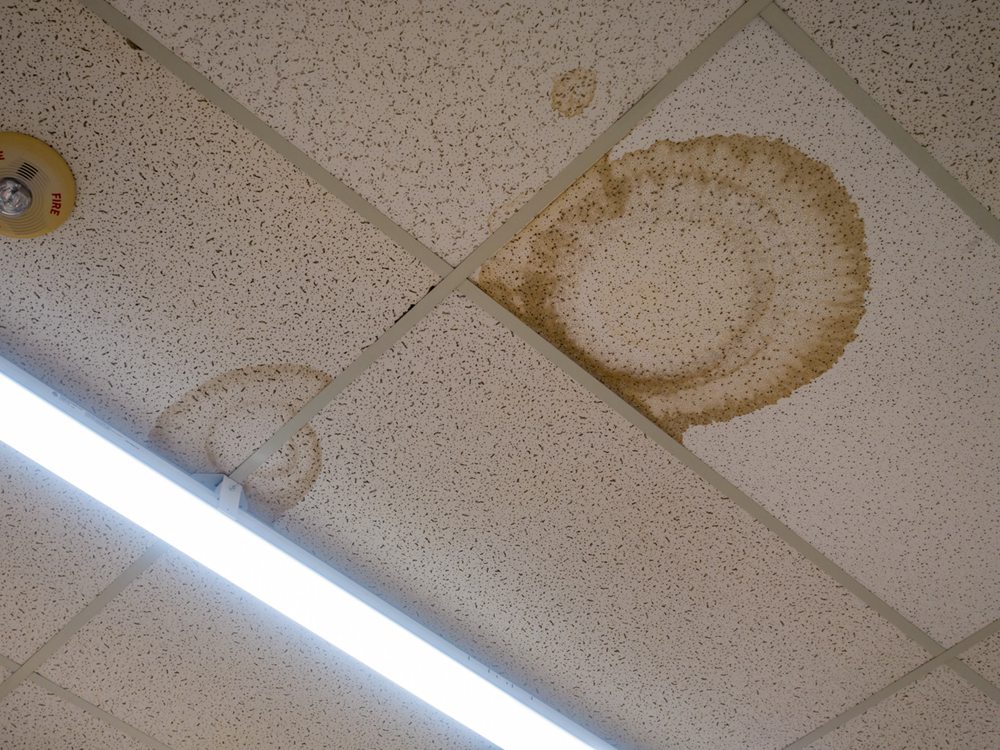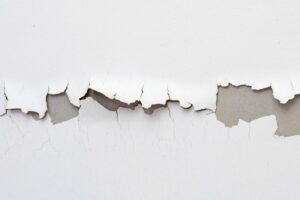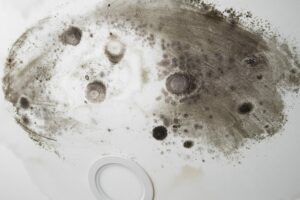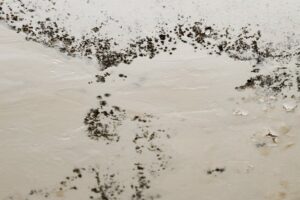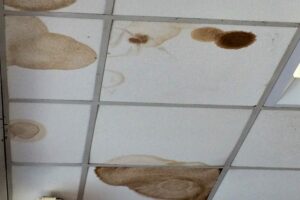Spotting yellow stains on your bathroom ceiling can be alarming. But don’t panic – these unsightly marks are usually harmless and often easy to treat. This comprehensive guide covers all the potential causes of yellow spots on your bathroom ceiling and how to tackle them. Read on to diagnose the issue and find the right fix to restore your ceiling to its original pristine white.
Table of Contents
What Causes Yellow Spots on Bathroom Ceilings?
There are several possible explanations for yellow stains on your bathroom ceiling:
Mold and Mildew
Excess moisture is the main cause of mold growth. Bathrooms tend to be damp spaces, so mold thrives there. Mold spores land on surfaces and feed on condensation, leaks, humidity from showers, and general dampness.
As the mold spreads, it produces yellowish or orange spots. Mold likes to hide in cracks, corners, and caulking. Check along the tub and shower, near vents and windows, and around fixtures for signs of slimy yellow mold.
Water Damage and Leaks
Leaks from above or moisture seeping through ceiling cracks can lead to yellow stains. Damp drywall soaks up stains like coffee, tea, and other liquids. Nicotine and smoke residue from cigarettes can also leave yellowish-brown stains if there’s a leak overhead.
Inspect plumbing fixtures, supply lines, drains, and your roof to spot any water damage or active leaks letting moisture through. Even small, slow leaks cause ugly stains over time.
Paint Issues
Latex paints can turn yellow due to sun exposure, age, cigarette smoke, and off-gassing from certain building materials. Oil-based paints also yellow with age as the binders deteriorate.
If you have indoor lights, exhaust fans, or skylights in the bathroom ceiling, the focused light and heat can accelerate yellowing on painted surfaces.
Mineral Deposits
Hard water containing high amounts of minerals can leave yellow stains on bathroom surfaces. Calcium, lime, and magnesium in the water interact with soap scum and leave hard-to-remove buildup.
This mineral residue sticks strongly to grout, caulking, chrome fixtures, and shower doors. Over time, it creeps onto the ceiling too.
Nicotine and Tar
If there are smokers in the house, residue from cigarettes can stain the ceiling yellow. The oily tar and nicotine vapors rise and stick to any surface.
Yellow stains often concentrate around a ceiling exhaust fan because it sucks up the smoke. But nicotine residue can spread across the entire ceiling over years of exposure.
Dangers of Yellow Stains on Bathroom Ceilings
Don’t dismiss yellow spots as just unsightly blemishes. Depending on the cause, they can pose the following health and safety risks:
- Respiratory illness – Toxic mold spores aggravate allergies and asthma. Inhaling high levels can cause mold-related infections.
- Wood rot – Moisture damage weakens ceiling structure, risking collapse and injury. Chronic leaks also breed mold.
- Mercury exposure – Some older interior paints contained mercury as a preservative. As paint degrades, old mercury residues could vaporize and be inhaled.
- Fire hazard – Heated tobacco smoke residues are flammable. Old nicotine stains raise the ceiling’s fire risk.
- Skin irritation – Skin contact with some mold, mildew, and bacteria breeds nasty rashes and infections.
Regularly inspect, clean, and repair your bathroom ceiling to ward off these hazards before they become dangerous.
How to Clean Yellow Stains from Your Bathroom Ceiling
Now that you know what causes yellow spots, it’s time to tackle removing them. Here are some effective cleaning methods to try:
Vinegar
White vinegar is a mild acid that dissolves mineral deposits, soap scum, grease, and nicotine stains. Mix equal parts vinegar and water in a spray bottle. Lightly mist the yellow spots and let sit for 15-20 minutes. Then scrub with a soft brush or sponge. Rinse thoroughly.
For tougher stains, use undiluted vinegar. The natural acetic acid in vinegar also kills mold and mildew.
Baking Soda
Baking soda is a gentle abrasive cleaner that lifts stains off surfaces. Mix a few tablespoons of baking soda with just enough water to form a paste. Apply to stained areas and let sit for 5-10 minutes. Scrub and wipe clean. Baking soda also deodorizes musty smells.
Hydrogen Peroxide
The bubbles in hydrogen peroxide help dislodge gunk and whiten yellow stains. Use 3% hydrogen peroxide solution from the drugstore. Spray or blot on affected areas and let bubble for 10 minutes before scrubbing clean. This works well on mold and nicotine stains. Rinse thoroughly afterward.
Mr. Clean Magic Eraser
These popular melamine foam cleaning pads lift dirt, grime, and stains with minimal scrubbing. Get the pads wet, then gently rub on yellow spots. The abrasive foam erases stains without damaging paint or drywall. Magic erasers also sanitize surfaces.
TSP Substitute
Trisodium phosphate (TSP) is a heavy-duty cleaner that tackles tough stains on walls. But TSP is caustic and bad for the environment. Look for safer TSP substitutes containing sodium carbonate. Mix as directed and scrub on discolored areas before rinsing. Wear gloves when using.
Bleach
As a last resort for stubborn yellow spots, try diluted household bleach. Mix 3 parts water to 1 part bleach in a spray bottle. Mist affected areas and let sit 5-10 minutes. Scrub with a sponge, then quickly rinse off all the bleach. Ensure good ventilation and never mix bleach with other cleaners. Bleach can damage fabrics, so cover nearby surfaces.
Preventing Yellow Spots on Your Bathroom Ceiling
Here are some tips to help prevent ugly yellow stains from forming on your bathroom ceiling:
Control Moisture
Excess moisture is the root cause of most yellow ceiling stains. To prevent them:
- Run the bathroom fan during and after showering/bathing. Make sure it is vented outside, not just recirculated into the bathroom air.
- Open a window while showering if possible.
- Fix any leaking faucets, pipes, or toilet tanks immediately.
- Wipe down shower walls and surfaces after use to remove condensation.
- Use a dehumidifier or increase air circulation if your bathroom has chronic high humidity.
Check for Leaks
Inspect your bathroom ceiling, walls, fixtures, and plumbing regularly for any signs of leaks or moisture damage. Water stains, warped drywall, or mold indicate a leak that needs fixing. Common problem areas include:
- Around the tub/shower
- Around the toilet, sink, or vanity
- At seams between drywall panels
- Near plumbing pipes in walls and ceilings
- Under windows where condensation forms
Fix any leaks right away before major ceiling or drywall damage occurs.
Improve Ventilation
Proper ventilation is key to preventing excess moisture that leads to yellow mold stains. Ensure your bathroom has:
- A working exhaust fan that runs during and after baths/showers
- Gap at bottom of door for air circulation
- Adequately sized bathroom window
- Vents that release air outside, not just recirculate it
- Exhaust fan ducts that vent directly outdoors without kinks
- Sufficient make-up airflow from outside via windows, transfers grills or ducts
Upgrade fans or ducting if your current setup is inadequate. Run fans longer to fully clear moist air.
Apply Mold-Resistant Paint
When repainting your bathroom ceiling, use mold/mildew resistant paint, especially in humid climates. The additives in these paints inhibit mold growth. Apply acrylic latex paint only after fixing any leaks and moisture issues first.
Clean Regularly
Dust, dirt, and soap scum act as food for mold, so clean bathroom surfaces frequently:
- Use a disinfecting cleaner weekly on the shower, sinks, tiles and grout.
- Vacuum and dust ceilings, vents and light fixtures monthly.
- Wipe down the ceiling periodically with diluted bleach or other antimicrobial cleaner to prevent buildup.
This helps prevent mold spores from taking hold and growing.
When to Repaint vs. Clean Ceiling Stains
Here is a simple table summarizing whether you should spot clean stains or do a full repainting:
| Type of Stain | Size of Stained Area | Recommended Solution |
|---|---|---|
| Recent light stains | Small spots or patches | Spot clean |
| Yellowing from age/wear | Over large area | Repaint entire ceiling |
| Severe damage from leaks | Large spots or patches | Spot clean, repair damage, repaint affected areas |
| Heavy smoke or mold stains | Medium to large patches | Spot clean multiple times then repaint |
| Stains remain after thorough cleaning | Small, medium or large area | Repaint ceiling |
As shown in the table, light or mild stains limited to small areas can often be managed through spot cleaning. But once stains are very set-in, widespread, or cover a larger percentage of the ceiling, repainting provides the most effective solution.
Frequently Asked Questions
Here are answers to some common questions about eliminating yellow ceiling stains in the bathroom:
What is the fastest way to get rid of yellow stains on my bathroom ceiling?
For quick stain removal, hydrogen peroxide works more rapidly than many other DIY methods. Simply spray it on the stains, allow to soak for just 5-10 minutes, then scrub clean. Baking soda paste also works fairly quickly, when given at least 15 minutes to lift stains before scrubbing.
What should I do if DIY stain removal doesn’t work?
First, try cleaning more aggressively with a repeated application of vinegar, hydrogen peroxide, or bathroom cleaner. Use a sturdier scrub brush. If stains still won’t budge, the next step is to repaint the ceiling with quality bathroom paint. Be sure to apply primer first on stained areas to block discoloration from showing through the new paint.
Why does my ceiling keep getting yellow stains back so quickly?
Recurring stains likely mean you have an ongoing moisture issue allowing mold growth. Make sure fans are used to actively ventilate the bathroom. Fix any leaks or condensation problems. Also clean the ceiling more frequently to prevent stain buildup. Using mold-resistant bathroom paint when repainting may also help.
Do I need to hire a professional if I have a large water stain?
Not necessarily. Large water stains can often be cleaned successfully with hydrogen peroxide, vinegar, or bleach cleaner. However, you do need to fix the source of the leak before repainting the damaged ceiling area. So professional repairs may be needed behind the walls or on the roof, for example.
Why is mold dangerous? Can’t I just scrub off the stains it leaves behind?
While mold stains can be cleaned, the mold itself needs special attention. Inhaling or touching mold spores can cause respiratory issues or allergic reactions. Killing the mold with products listed here is vital. Prolonged moisture enabling mold growth also needs to be addressed. Preventing mold is healthier than just cleaning stains repeatedly.
In summary, ugly yellow stains on your bathroom ceiling can happen due to mold, moisture, smoking, or age. But don’t let them ruin the look of your bathroom. With the effective solutions listed above, including DIY cleaners and scrubbing methods, you can banish unsightly stains for good. Address any underlying causes to prevent recurrence. And know when it’s time to call in a professional for assistance. Taking action to get rid of ceiling stains provides a more inviting, refreshed bathroom space.


